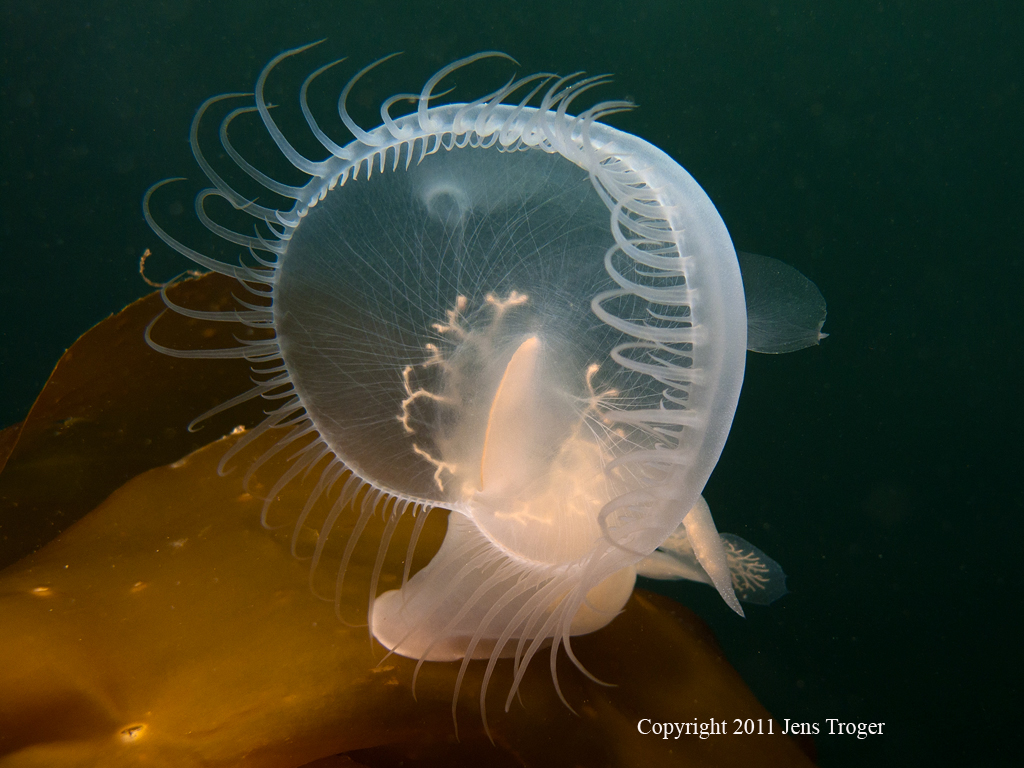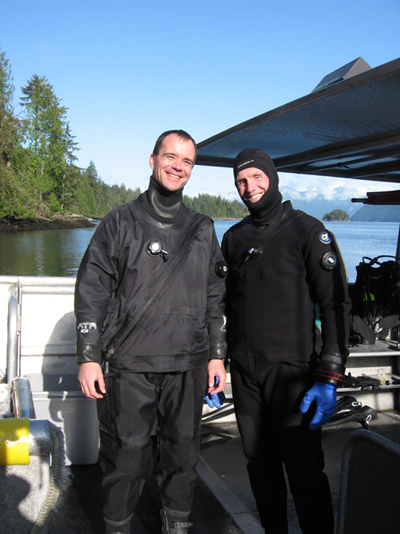 |
Melibe leonina
Image courtesy of Jens TrogerHussar Bay, Port Hardy, BC in Canada in October of 2010
Canon G10 with a FIX housing, two Sea&Sea strobes shooting manual.
Copyright 2011, Jens Troger
This is truly a spectacular photo of this amazing nudibranch. Jens' unusual angle gives us a rare peek at the internal anatomy of this species signature, unique anatomical feature - its large oral hood.
Belonging to the family Tethydidea, all members have a well developed oral hood ringed with numerous elongate papillae. It is the only nudibranch group specializing on feeding on crustaceans. Coincidentally, this feeding technique often lands a larval fish or two. Enjoy a short video put together by the Webmaster which illustrates the aforementioned behavior by one of Melibe leonina's distant cousins in the Philippines!
The hood is cast forward much like a Hawai'ian fisherman throws his net. In Jens photo we can see that Melibe leonina has two rings on papillae on the edge of the hood, the more lateral being many times longer, than those in the inner row. These papillae not only sense and locate potential prey, but once the prey is captured, the papillae inter-digitate to trap the prey securely within the hood. A carnivorous plant using the same technique is the insect eating, Venus flytrap. These papillations give this species the name - leonina - for its lion's mane appearance.
The hood is then reduced in size forcing the prey towards the animal's mouth, which is the vertical white crescent at the center of the hood. Adjacent to the mouth we can see a number of branches of the vascular gut that extend into the head and hood region. The branches are denser in the animal's cerata, as seen to the right and rear.
Next we can see dozens of thin white hair-like lines which cross each other. These fine striations are the muscles used to open and throw the hood, and retract it back in.
If this specialized feeding apparatus isn't enough to make this critter special - Hey, it's an excellent swimmer, undulating its body from side to side to escape protagonists.
At the northern-most reaches of its range, specimens may reach 6 inches in length, much larger than more southern divers are used to seeing. Diver's see this in many sea slugs species in Washington and British Columbia. The phenomenon is referred to as "Bergmann's Law." Unfortunately Bergmann wrote his principle based on longitudinal differences in size in insects and birds. Most of these terrestrial species being represented by larger size individuals as you go farther north. The Law has yet to be tested for marine invertebrates, but from what I have seen in numerous nudibranch species up here, the Law may well apply to them also.
Gig Harbor, Washington
May, 2011
Jens Troger diving with friend Marc Chamberlain (right)
in Egmont, BC.
Marc probably needs no introduction to readers
as Marc has been a solid supporter of the
site from inception.
Marc was in fact was the presenter two weeks ago!
 |
Jens has been diving for more than 10 years, 6 of that in the Pacific Northwest. Jens lives in Seattle, Washington. Jens loves to travel all over the world to dive but considers himself very lucky and happy to live in the Pacific Northwest here where phenomenal diving is literally just outside of my door step. Jens also teachs scuba occasionally. Send Jens email at savage@light-speed.de |

|
